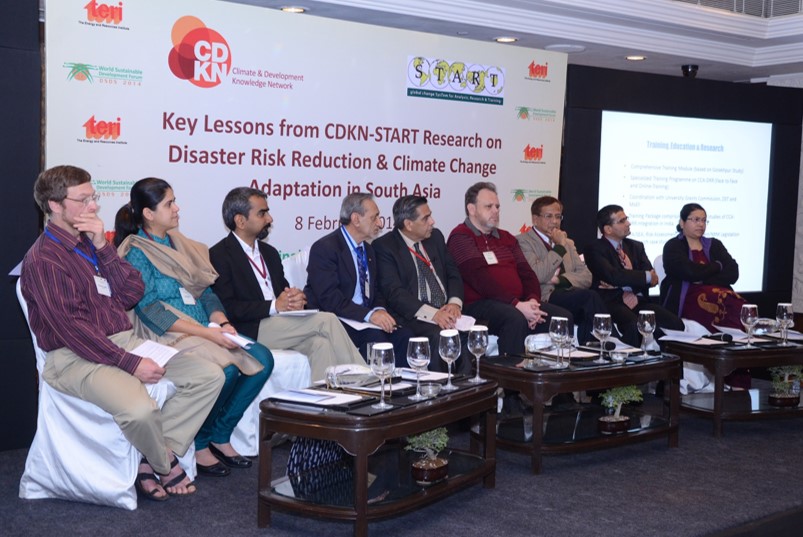Exploring resilience in climate compatible development
Exploring resilience in climate compatible development
Mihir Bhatt, CDKN’s Senior Advisor in India, considers what we can learn about resilience from CDKN’s South Asia research programme.
What is resilience and what implications does it have for climate compatible development (CCD) in South Asia? This important question was raised by excellent presentations from CDKN’s partners carrying out action research on achieving climate-smart disaster risk reduction in South Asia during a CDKN/START session on February 8, 2014 at the Delhi Sustainable Development Summit (DSDS).
Resilience is an integral part of sustainable development and as such has to be searched for and supported with deliberate efforts, said Ali T. Sheikh, CDKN Asia Director, in his opening remarks. As a facilitator to this packed event I was wondering what exactly is being searched for by some of the most exploratory CCD projects in India, Nepal, and Pakistan? The following points may provide an answer to this question.
The face of resilience. What does resilience look like at the individual level? The human aspect of resilience is something that remains by and large invisible during global debates on CCD. SEEDS’s work with communities living in +500C heat in Rajasthan desert to -50 0C cold in Ladakh Himalayas has started to touch this question with accurate and moving visual material of households struggling to adapt to the impact of climate change and natural disasters. Through research as well as great communication material, the team put the ‘invisible disaster’ facing the nomadic tribe of Changpas in Changthang, Eastern Ladakh last year on the agenda.
Measuring and managing resilience. How can resilience be measured? In what units? Who should measure it? When? Without measuring it, resilience cannot be managed. This is the focus of Nepal Development Research Institute (NDRI’s) policy research work in the Koshi river basin across the border dividing India and Nepal. By assessing the climate related stressors on hydro-meteorology of the basin, they are revisiting the design values of proposed infrastructure such as dams, barrages and embankments. Their process of measuring and managing resilience is relevant for any river basin or water sector development initiative in the region.
Speeding up resilience. The scale of risks faced by vulnerable communities in South Asia is increasingly overwhelming their level of resilience. Resilience often remains a step behind risk. How can this gap be bridged? Does the size or scale of the risk-resilience gap matter? Is covering up the gap enough? Should there be a buffer of resilience for the poor against risk? And how wide should this buffer be? ATREE’s work in the East Himalayan region has studied the 2009 cyclone and the 2011 earthquake in Darjeeling and Sikkim and demonstrated that the resilience ‘gap’ for infrastructure such as dams and road is putting development goals and risk. In Pakistan, WWF is doing a similar analysis for livelihoods in coastal communities and exploring what such a ‘buffer of resilience’ could look like.
Interaction of Resilience with safety nets. Can safety nets or coping mechanisms—formal and informal—capture falling or failing resilience? Or in fact prop it up? What can be done when there are no such nets in the lives of the poor? What should be done when the state is yet to build such a safety net? ISET and GEAG’s work in eastern India, in flood-prone Gorakhpur district, has worked with officials and stakeholders from all sectors to identify the roles and responsibilities for providing such safety nets.
Financing resilience building by women. Domestic resilience is built by women. Their role—as home makers as well as workers—is most crucial in shaping resilience. How to finance these efforts so that more and more resilience is built at the household level? Household resilience helps keep risks away longer. Intercooperation and AIDMI’s work on the Odisha coast has illustrated both the demand for such investment in women and their groups and also the impact of such investment when it is made. This evidence should influence decisions of where and how to fund development and disaster recovery.
The CDKN-START projects have experimented with pioneering approaches to building resilience through convergence of disaster risk reduction and adaptation to the impacts of climate change. The lessons from these projects are relevant to policy-makers and practitioners across the region.
During such discussions on climate change and disaster risk, the projections of the future tend to be bleak. While we know how to build resilience and protect our future, the scale of the challenge makes this look like an impossible task. But, as Hassan Virjee from START concluded, tomorrow’s reality is not already defined. Our actions today will determine our future.

